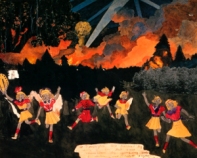Researching artists who collect, artists who question collecting, and artists who obsessively collect made me wonder: are all artists a little bit, or a lot, eccentric? All of the artists I and my fellow art students researched were eccentric on some level, ranging from the slightly off centre to two miles over the edge.
Creative people do have a bit of a reputation for being eccentric, not just artists but writers also. For example Charles Dickens is said to have fended off imaginary urchins with his umbrella as he walked the streets of London. But it seems that eccentricity, or some degree of it, might be a prerequisite for having a creative disposition. Some might argue that eccentricity is a mild form of mental instability. I’m not so sure. I think you can be eccentric, yet perfectly of sound mind.
The internet tells me that both creativity and eccentricity may be the result of genetic variations that increase cognitive disinhibition. In other words, the brain’s failure to filter out extraneous information. So creativity and eccentricity are the result of bad genes it seems.
The internet also listed for me the ten most eccentric artists (this is someone else’s opinion, not my own, but worth stealing). These artists’ eccentricities can be summarized as follows:
1. Michelangelo. This very famous man was known for his many quirks and unique behaviours. He was bad tempered and earned himself a reputation for screaming at statues and slamming at their appendages in a variety of emotional states perhaps expecting a response. He also happily lived in poverty in spite of his financial successes.
2. Leonardo da Vinci. This true Renaissance man wrote most of his notes backwards (he was left-handed, the best artists always are in my opinion). Some think he did this to hide the true meaning in his notes, others say he just preferred to do it that way (I subscribe to the latter opinion). He dressed in bright colors, short tunics, and man tights considered more appropriate for younger men. He also favoured long, flowing hair and a beard at a time when closely cropped, clean shaven looks were more in fashion.
3. Van Gogh. No need really to elaborate here.
4. Frida Kahlo. Using extreme physical and emotional traumas for inspiration, her paintings and life showed an obsession and preoccupation with pain and how it comes to physically and emotionally shape who we are. Kahlo suffered the traumas caused by her husband’s philandering behaviour, despite being as guilty as him of similar misdeeds.
5. Henry Darger. This guy spent most of his life collecting (yet another collector) bits of rubbish that he found of interest. None of his friends and family knew about his obsessions and artwork until after his death when his landlord discovered a stunning store of amazing literature and artwork.
6. Andy Warhol. Say no more.
7. Salvador Dali. The mustache says it all. Added to that Dali had a tendency to refer to himself in the third person.
8. Daniel Johnston. Johnston attracted a number fans by giving out tapes to anyone and everyone he came across. His watercolors and sketches have an almost childlike quality to them, incorporating popular characters such as Captain America and Casper the Friendly Ghost. They reflect many of his almost childlike perspectives on the world.
9. Paul Gauguin. Gauguin harboured a strong obsession with cultures outside of his own, a hobby which remained fairly harmless, in fact it had a positive effect on his work. He fervently hoarded art and crafts from as far away as Japan, Tahiti, Martinique, Panama, Polynesia, and others as a means of inspiring what would later become highly influential work. Another collector it seems.
10. Pablo Picasso. And yet another famous collector, Picasso collected women.
What do these ten people have in common, besides bad genes and peculiar quirks? Genuine creative people are constantly reinventing themselves. Anyone facing a difficult and challenging task is going to display some form of eccentricity. Artists need to analyse what they are doing that’s different from the norm, which includes collecting, testing, analysing, representing, teaching, displaying and looking. Surely uniqueness should be celebrated. So what making good art involves striping to your pants and dancing around the garden?
References:
Mark McGuiness ‘Why Creative People Need to be Eccentric’, 99U, http://99u.com/tips/7021/Why-Creative-People-Need-to-Be-Eccentric [last accessed 5 November 2012]
Shelley Carson, ‘The Unleashed Mind: Why Creative People Are Eccentric’, Scientific American, http://www.scientificamerican.com/article.cfm?id=the-unleashed-mind [last accessed 5 November 2012]
10 Most Eccentric Artists Ever to Live, Graphic Design Press, http://graphicdesigndegrees.org/10-most-eccentric-artists-ever-to-live/ [last accessed 5 November2012]






